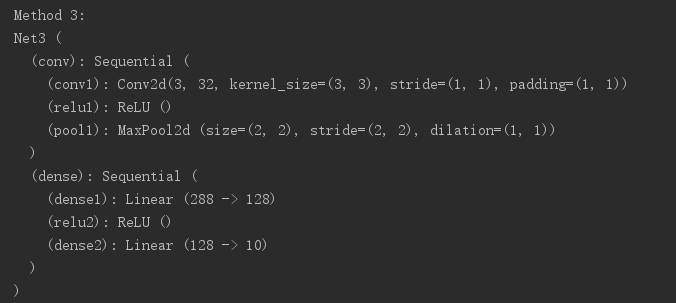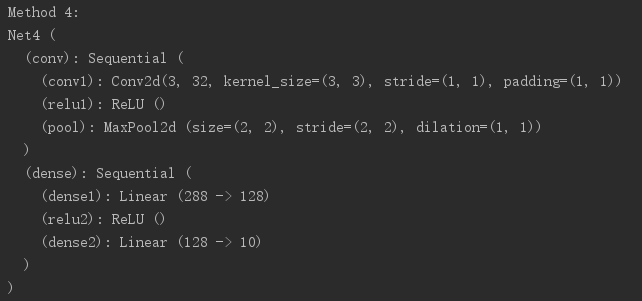pytorch学习: 构建网络模型的几种方法
利用pytorch来构建网络模型有很多种方法,以下简单列出其中的四种。
假设构建一个网络模型如下:
卷积层--》Relu层--》池化层--》全连接层--》Relu层--》全连接层
首先导入几种方法用到的包:
import torch
import torch.nn.functional as F
from collections import OrderedDict
第一种方法
# Method 1 ----------------------------------------- class Net1(torch.nn.Module):
def __init__(self):
super(Net1, self).__init__()
self.conv1 = torch.nn.Conv2d(3, 32, 3, 1, 1)
self.dense1 = torch.nn.Linear(32 * 3 * 3, 128)
self.dense2 = torch.nn.Linear(128, 10) def forward(self, x):
x = F.max_pool2d(F.relu(self.conv(x)), 2)
x = x.view(x.size(0), -1)
x = F.relu(self.dense1(x))
x = self.dense2(x)
return x print("Method 1:")
model1 = Net1()
print(model1)

这种方法比较常用,早期的教程通常就是使用这种方法。
第二种方法
# Method 2 ------------------------------------------
class Net2(torch.nn.Module):
def __init__(self):
super(Net2, self).__init__()
self.conv = torch.nn.Sequential(
torch.nn.Conv2d(3, 32, 3, 1, 1),
torch.nn.ReLU(),
torch.nn.MaxPool2d(2))
self.dense = torch.nn.Sequential(
torch.nn.Linear(32 * 3 * 3, 128),
torch.nn.ReLU(),
torch.nn.Linear(128, 10)
) def forward(self, x):
conv_out = self.conv1(x)
res = conv_out.view(conv_out.size(0), -1)
out = self.dense(res)
return out print("Method 2:")
model2 = Net2()
print(model2)

这种方法利用torch.nn.Sequential()容器进行快速搭建,模型的各层被顺序添加到容器中。缺点是每层的编号是默认的阿拉伯数字,不易区分。
第三种方法:
# Method 3 -------------------------------
class Net3(torch.nn.Module):
def __init__(self):
super(Net3, self).__init__()
self.conv=torch.nn.Sequential()
self.conv.add_module("conv1",torch.nn.Conv2d(3, 32, 3, 1, 1))
self.conv.add_module("relu1",torch.nn.ReLU())
self.conv.add_module("pool1",torch.nn.MaxPool2d(2))
self.dense = torch.nn.Sequential()
self.dense.add_module("dense1",torch.nn.Linear(32 * 3 * 3, 128))
self.dense.add_module("relu2",torch.nn.ReLU())
self.dense.add_module("dense2",torch.nn.Linear(128, 10)) def forward(self, x):
conv_out = self.conv1(x)
res = conv_out.view(conv_out.size(0), -1)
out = self.dense(res)
return out print("Method 3:")
model3 = Net3()
print(model3)

这种方法是对第二种方法的改进:通过add_module()添加每一层,并且为每一层增加了一个单独的名字。
第四种方法:
# Method 4 ------------------------------------------
class Net4(torch.nn.Module):
def __init__(self):
super(Net4, self).__init__()
self.conv = torch.nn.Sequential(
OrderedDict(
[
("conv1", torch.nn.Conv2d(3, 32, 3, 1, 1)),
("relu1", torch.nn.ReLU()),
("pool", torch.nn.MaxPool2d(2))
]
)) self.dense = torch.nn.Sequential(
OrderedDict([
("dense1", torch.nn.Linear(32 * 3 * 3, 128)),
("relu2", torch.nn.ReLU()),
("dense2", torch.nn.Linear(128, 10))
])
) def forward(self, x):
conv_out = self.conv1(x)
res = conv_out.view(conv_out.size(0), -1)
out = self.dense(res)
return out print("Method 4:")
model4 = Net4()
print(model4)

是第三种方法的另外一种写法,通过字典的形式添加每一层,并且设置单独的层名称。
完整代码:
import torch
import torch.nn.functional as F
from collections import OrderedDict # Method 1 ----------------------------------------- class Net1(torch.nn.Module):
def __init__(self):
super(Net1, self).__init__()
self.conv1 = torch.nn.Conv2d(3, 32, 3, 1, 1)
self.dense1 = torch.nn.Linear(32 * 3 * 3, 128)
self.dense2 = torch.nn.Linear(128, 10) def forward(self, x):
x = F.max_pool2d(F.relu(self.conv(x)), 2)
x = x.view(x.size(0), -1)
x = F.relu(self.dense1(x))
x = self.dense2()
return x print("Method 1:")
model1 = Net1()
print(model1) # Method 2 ------------------------------------------
class Net2(torch.nn.Module):
def __init__(self):
super(Net2, self).__init__()
self.conv = torch.nn.Sequential(
torch.nn.Conv2d(3, 32, 3, 1, 1),
torch.nn.ReLU(),
torch.nn.MaxPool2d(2))
self.dense = torch.nn.Sequential(
torch.nn.Linear(32 * 3 * 3, 128),
torch.nn.ReLU(),
torch.nn.Linear(128, 10)
) def forward(self, x):
conv_out = self.conv1(x)
res = conv_out.view(conv_out.size(0), -1)
out = self.dense(res)
return out print("Method 2:")
model2 = Net2()
print(model2) # Method 3 -------------------------------
class Net3(torch.nn.Module):
def __init__(self):
super(Net3, self).__init__()
self.conv=torch.nn.Sequential()
self.conv.add_module("conv1",torch.nn.Conv2d(3, 32, 3, 1, 1))
self.conv.add_module("relu1",torch.nn.ReLU())
self.conv.add_module("pool1",torch.nn.MaxPool2d(2))
self.dense = torch.nn.Sequential()
self.dense.add_module("dense1",torch.nn.Linear(32 * 3 * 3, 128))
self.dense.add_module("relu2",torch.nn.ReLU())
self.dense.add_module("dense2",torch.nn.Linear(128, 10)) def forward(self, x):
conv_out = self.conv1(x)
res = conv_out.view(conv_out.size(0), -1)
out = self.dense(res)
return out print("Method 3:")
model3 = Net3()
print(model3) # Method 4 ------------------------------------------
class Net4(torch.nn.Module):
def __init__(self):
super(Net4, self).__init__()
self.conv = torch.nn.Sequential(
OrderedDict(
[
("conv1", torch.nn.Conv2d(3, 32, 3, 1, 1)),
("relu1", torch.nn.ReLU()),
("pool", torch.nn.MaxPool2d(2))
]
)) self.dense = torch.nn.Sequential(
OrderedDict([
("dense1", torch.nn.Linear(32 * 3 * 3, 128)),
("relu2", torch.nn.ReLU()),
("dense2", torch.nn.Linear(128, 10))
])
) def forward(self, x):
conv_out = self.conv1(x)
res = conv_out.view(conv_out.size(0), -1)
out = self.dense(res)
return out print("Method 4:")
model4 = Net4()
print(model4)
pytorch学习: 构建网络模型的几种方法的更多相关文章
- 在ASP.NET Core中构建路由的5种方法
原文链接 :https://stormpath.com/blog/routing-in-asp-net-core 在ASP.NET Core中构建路由的5种方法 原文链接 :https://storm ...
- C#调用接口注意要点 socket,模拟服务器、客户端通信 在ASP.NET Core中构建路由的5种方法
C#调用接口注意要点 在用C#调用接口的时候,遇到需要通过调用登录接口才能调用其他的接口,因为在其他的接口需要在登录的状态下保存Cookie值才能有权限调用, 所以首先需要通过调用登录接口来保存c ...
- Linux系统学习07-Centos软件安装几种方法
配置好Centos一些基础设置后,接下来就是学习平时使用最多的软件安装. windwos下软件安装非常简单,就是下载好安装包,然后双击就会自动安装. 而Centos里面安装软件的方式方法有区别,熟悉几 ...
- 提高webpack的构建速度的几种方法概括
通过externals配置来提取常用库 利用DllPlugin和DllReferencePlugin预编译资源模块,通过DllPlugin来对那些我们引用但是绝对不会修改的npm包来进行预编译,再通过 ...
- pytorch 建立模型的几种方法
利用pytorch来构建网络模型,常用的有如下三种方式 前向传播网络具有如下结构: 卷积层-->Relu层-->池化层-->全连接层-->Relu层 对各Conv2d和Line ...
- 海康威视采集卡结合opencv使用(两种方法)-转
(注:第一种方法是我的原创 ^_^. 第二种方法是从网上学习的.) 第一种方法:利用 板卡的API: GetJpegImage 得到 Jpeg 格式的图像数据,然后用opencv里的一个函数进行解码 ...
- PyTorch如何构建深度学习模型?
简介 每过一段时间,就会有一个深度学习库被开发,这些深度学习库往往可以改变深度学习领域的景观.Pytorch就是这样一个库. 在过去的一段时间里,我研究了Pytorch,我惊叹于它的操作简易.Pyto ...
- Java学习笔记——可视化Swing中JTable控件绑定SQL数据源的两种方法
在 MyEclipse 的可视化 Swing 中,有 JTable 控件. JTable 用来显示和编辑常规二维单元表. 那么,如何将 数据库SQL中的数据绑定至JTable中呢? 在这里,提供两种方 ...
- 学习之路十四:客户端调用WCF服务的几种方法小议
最近项目中接触了一点WCF的知识,也就是怎么调用WCF服务,上网查了一些资料,很快就搞出来,可是不符合头的要求,主要有以下几个方面: ①WCF的地址会变动,地址虽变,但是里面的逻辑不变! ②不要引用W ...
随机推荐
- python全栈开发day117-MongoDB,pymongo
1.MongoDB操作 使用了不存在的对象即创建该对象 1.增加: 官方不推荐写法: insert([{},{},{}]) 官方推荐写法: insertOne({}) insertMany([{},{ ...
- PCA:利用PCA(四个主成分的贡献率就才达100%)降维提高测试集辛烷值含量预测准确度并《测试集辛烷值含量预测结果对比》—Jason niu
load spectra; temp = randperm(size(NIR, 1)); P_train = NIR(temp(1:50),:); T_train = octane(temp(1:50 ...
- Qwt 编译 配置 使用
QWT,全称是Qt Widgets for Technical Applications,是一个基于LGPL版权协议的开源项目,可生成各种统计图.它为具有技术专业背景的程序提供GUI组件和一组实用类, ...
- css实现图片等比例缩放
<div class="box"> <img src="01.jpg"/> </div> .box{ } //只要给图片设置 ...
- Redis数据库概述
Redis数据库概述 Redis是什么 redis是一个高性能的key-value存储系统.支持的value类型相对更多,包括string,list,set,zset(sorted set --有序集 ...
- Pi 3B+编译安装python3.6.8
树莓派镜像版本2018-11-13,更新到2019-01-09 sudo apt-get update sudo apt-get upgrade -dev libgdbm-dev libsqlite3 ...
- 快速安装puppeteer (跳过安装Chromium)
npm i --save puppeteer --ignore-scripts
- vue 学习小记
vue 中有 data() .computed.methods.beforeRouteLeave.created等 具体的: data():定义一些文件中需要用到的变量,data中带return,是使 ...
- mysql命名规范
1.数据库表命名规范: (1)表名前应该加上前缀,表的前缀一个用系统或模块的英文名称缩写,前缀全部大写或首字母大写,表名中包含的单词首字母大写. (2)数据库表名应该有意义,并且易于理解,最好使用可以 ...
- java常用数据类型使用Day008
1,java常用数据类型使用 package cn.edu.fhj.day008; import java.util.ArrayList; import java.util.HashMap; impo ...
